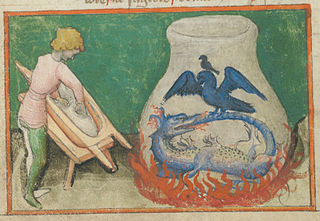
Alchemy is an ancient branch of natural philosophy, a philosophical and protoscientific tradition that was historically practiced in China, India, the Muslim world, and Europe. In its Western form, alchemy is first attested in a number of pseudepigraphical texts written in Greco-Roman Egypt during the first few centuries AD.
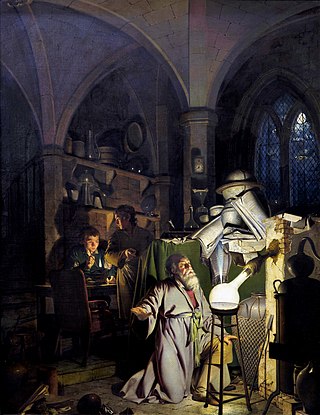
The philosopher's stone, or more properly philosophers' stone, is a mythic alchemical substance capable of turning base metals such as mercury into gold or silver. It is also called the elixir of life, useful for rejuvenation and for achieving immortality; for many centuries, it was the most sought-after goal in alchemy. The philosopher's stone was the central symbol of the mystical terminology of alchemy, symbolizing perfection at its finest, enlightenment, and heavenly bliss. Efforts to discover the philosopher's stone were known as the Magnum Opus.
In analytical psychology, the shadow is an unconscious aspect of the personality that does not correspond with the ego ideal, leading the ego to resist and project the shadow. In short, the shadow is the self's emotional blind spot, projected ; e.g., trickster.
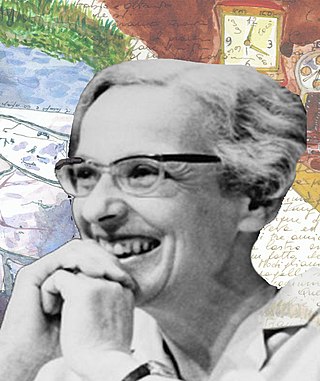
Marie-Louise von Franz was a Swiss Jungian psychologist and scholar, known for her psychological interpretations of fairy tales and of alchemical manuscripts.
The anima and animus are a syzygy of dualistic, Jungian archetypes among the array of other animistic parts within the Self in Jungian psychology, described in analytical psychology and archetypal psychology, under the umbrella of transpersonal psychology. The Jungian parts of the Self are a priori part of the infinite set of archetypes within the collective unconscious. Modern Jungian clinical theory under the analytical/archetypal -psych framework considers a syzygy-without-its-partner like yin without yang: countertransference reveals that logos and/or eros are in need of repair through a psychopomp, mediating the identified patient's Self; this theoretical model is similar to positive psychology's understanding of a well-tuned personality through something like a Goldilocks principle.
In alchemy, nigredo, or blackness, means putrefaction or decomposition. Many alchemists believed that as a first step in the pathway to the philosopher's stone, all alchemical ingredients had to be cleansed and cooked extensively to a uniform black matter.

Zosimos of Panopolis was a Greco-Egyptian alchemist and Gnostic mystic who lived at the end of the 3rd and beginning of the 4th century AD. He was born in Panopolis, and flourished ca. 300. He wrote the oldest known books on alchemy, which he called "Cheirokmeta," using the Greek word for "things made by hand." Pieces of this work survive in the original Greek language and in translations into Syriac or Arabic. He is one of about 40 authors represented in a compendium of alchemical writings that was probably put together in Constantinople in the 7th or 8th century AD, copies of which exist in manuscripts in Venice and Paris. Stephen of Alexandria is another.

Titus Burckhardt was a Swiss writer and a leading member of the Perennialist or Traditionalist School. He was the author of numerous works on metaphysics, cosmology, anthropology, esoterism, alchemy, Sufism, symbolism and sacred art.

Sufi cosmology is a Sufi approach to cosmology which discusses the creation of man and the universe, which according to mystics are the fundamental grounds upon which Islamic religious universe is based. According to Sufi cosmology, God's reason for the creation of this cosmos and humankind is the "manifestation" and "recognition" of Himself as it is stated in Hadith Qudsi – "I was a hidden Treasure; I desired to be recognized so I created the creature".

In psychology, the psyche is the totality of the human mind, conscious and unconscious.

Rubedo is a Latin word meaning "redness" that was adopted by alchemists to define the fourth and final major stage in their magnum opus. Both gold and the philosopher's stone were associated with the color red, as rubedo signaled alchemical success, and the end of the great work. Rubedo is also known by the Greek word iosis.
Citrinitas, or sometimes xanthosis, is a term given by alchemists to "yellowness." It is one of the four major stages of the alchemical magnum opus. In alchemical philosophy, citrinitas stood for the dawning of the "solar light" inherent in one's being, and that the reflective "lunar or soul light" was no longer necessary. The other three alchemical stages were nigredo (blackness), albedo (whiteness), and rubedo (redness).
Psychology and Alchemy, volume 12 in The Collected Works of C. G. Jung, is Carl Jung's study of the analogies between alchemy, Christian dogma, and psychological symbolism.

In alchemical and Hermetic traditions, suns are used to symbolize a variety of concepts, much like the Sun in astrology. Suns can correspond to gold, citrinitas, generative masculine principles, imagery of "the king", or Apollo, the fiery spirit or sulfur, the divine spark in man, nobility, or incorruptibility. Recurring images of specific solar motifs can be found in the form of a "dark" or "black sun", or a green lion devouring the Sun.
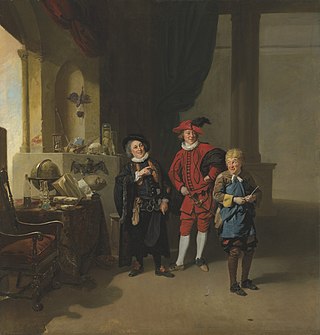
Alchemy has had a long-standing relationship with art, seen both in alchemical texts and in mainstream entertainment. Literary alchemy appears throughout the history of English literature from Shakespeare to modern Fantasy authors. Here, characters or plot structure follow an alchemical magnum opus. In the fourteenth century, Chaucer began a trend of alchemical satire that can still be seen in recent fantasy works like those of Terry Pratchett.

The Abyss is a 1968 novel by the Belgian-French writer Marguerite Yourcenar. Its narrative centers on the life and death of Zeno, a physician, philosopher, scientist and alchemist born in Bruges during the Renaissance era. The book was published in France in 1968 and was met with immediate popular interest as well as critical acclaim, obtaining the Prix Femina with unanimous votes the year of its publication. The English translation by Grace Frick has been published under the title The Abyss or alternatively Zeno of Bruges. Belgian filmmaker André Delvaux adapted it into a film in 1988.
Patrick Harpur is an English writer. He lives in Dorset, United Kingdom. He is best known for the work Daimonic Reality: A Field Guide to the Otherworld which deals with the paranormal in a similar way that Jacques Vallee, Allen Hynek and John Keel have done in the past.
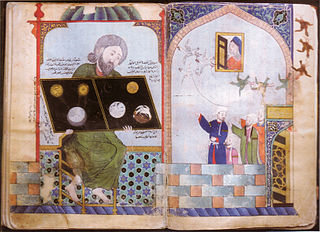
Alchemy in the medieval Islamic world refers to both traditional alchemy and early practical chemistry by Muslim scholars in the medieval Islamic world. The word alchemy was derived from the Arabic word كيمياء or kīmiyāʾ and may ultimately derive from the ancient Egyptian word kemi, meaning black.
The following outline is provided as an overview of and topical guide to alchemy:

The Great Work is an alchemical term for the process of working with the prima materia to create the philosopher's stone. It has been used to describe personal and spiritual transmutation in the Hermetic tradition, attached to laboratory processes and chemical color changes, used as a model for the individuation process, and as a device in art and literature. The magnum opus has been carried forward in New Age and neo-Hermetic movements which sometimes attached new symbolism and significance to the processes. The original process philosophy has four stages:













